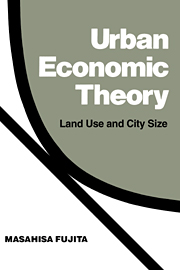7 - Neighborhood externalities and traffic congestion
Published online by Cambridge University Press: 23 December 2009
Summary
Introduction
A city is a place where a large number of people reside in close quarters. This concentration of people causes various kinds of technological externalities. There are both positive (beneficial) and negative (harmful) externalities. For example, externalities from local public goods, which were discussed in the preceding chapter, represent the most important types of positive externalities. In this chapter, we focus on the negative externalities that arise as the consequences of interactions among households themselves. In particular, we consider three different types of such externalities: crowding externalities, racial (or ethnic) externalities, and traffic congestion associated with commuting.
As the density of households in a neighborhood increases, the environmental quality tends to diminish partly because of an increase in noise, littering, crimes, and so on and partly because of a decrease in the open space and green areas in a neighborhood. Such negative consequences of household concentrations, called crowding externalities, may occur even if the residents of a city consist of relatively homogeneous households. On the other hand, in a city with more than one racial or ethnic group, if some groups have prejudices against other groups, the prejudiced groups feel that they suffer from the presence of these other groups in their neighborhoods. For example, some whites may have a prejudice against living near blacks. We call such externalities caused by prejudices among different groups racial externalities. Both crowding externalities and racial externalities arise because of the closeness of residences; hence, together we call them neighborhood externalities.
- Type
- Chapter
- Information
- Urban Economic TheoryLand Use and City Size, pp. 226 - 270Publisher: Cambridge University PressPrint publication year: 1989



